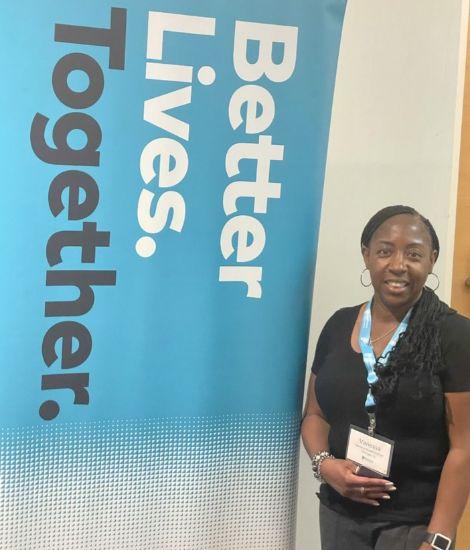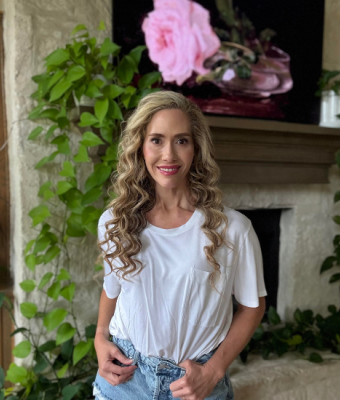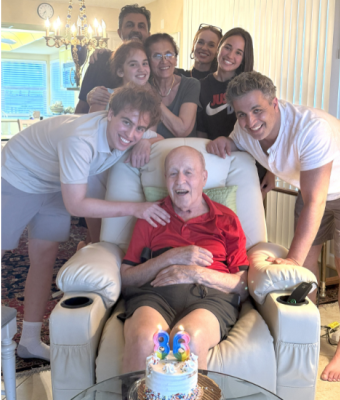My PD Story

Vanessa Russell-Palmer
My Parkinson’s disease (PD) story started with a severe orthopedic injury on July 26, 2015. I fell off a ladder in my garage and suffered a tibial plateau fracture of my left leg (I broke my left knee joint). After two weeks in the hospital and two surgeries, I was recuperating at my daughter’s house since I was non-weight bearing for over four months and could not live alone. In October, I noticed that whenever I was sitting still, I felt like my right hand was shaking, but when I looked at my hand, I couldn’t see any movement.
I mentioned this to my orthopedic surgeon and his initial thought was let’s keep an eye on it since I had suffered a lot of damage to my sciatic nerve because of my fall in July.
By April of 2016 the internal tremor had turned into a resting tremor, and I scheduled an appointment to see a neurologist. I had my initial neurology appointment in June 2016. I scheduled the appointment over my lunch hour because quite frankly I thought the tremor was related to the nerve damage from my fall — a Parkinson’s diagnosis was the farthest thing from my mind.
During my visit the neurologist took me through a battery of tests. When the neurologist had completed all the screenings, she asked me if a family member came with me to the appointment — of course, by now I’m getting concerned. I said that I came alone as I scheduled this appointment over my lunch hour. The neurologist proceeded to tell me that I have young-onset Parkinson’s disease.
I was stunned and in shock. The neurologist explained that Parkinson’s is a clinical diagnosis and I had several of the movement symptoms (tremor, bradykinesia and rigid muscles). The neurologist also ordered some diagnostics tests including blood work, a brain MRI and a DaT scan.
A few months later, I sought a second opinion on my diagnosis and saw a movement disorders specialist (MDS) at Rush University Medical Center, a Parkinson’s Foundation Center of Excellence. It was confirmed — I indeed had Parkinson’s.
Initially, my symptoms were mild, so I wasn’t put on any medication, which was fine with me because I was still very much in denial. I went on with work like nothing was wrong, but that didn’t last very long.
By 2017, I was struggling to manage my work and personal activities. Working in international accounting, I traveled a lot for work. I would hide my tremor during presentations, but the non-movement symptoms overwhelmed me (fatigue, brain fog, insomnia). It wasn’t until my MDS put me on amantadine when I started to believe I had Parkinson’s.
In 2018, I retired from my position as an accounting manager at a pharmaceutical company. Retirement was the right decision for me because I could see how the stress of work coupled with all my other responsibilities was negatively affecting me and making my PD symptoms worse. I started taking Carbidopa-Levodopa.
Fast forward to now, 2024. I’m actively involved in the newly formed African American support group at Rush. It was through this support group that I learned about the Parkinson’s Foundation Learning Institute. I was immediately interested and thrilled to be chosen (along with my daughter who is my care partner).
In September 2023, I was in the first graduating class of all Black and African American research advocates.
As a Parkinson’s Foundation Research Advocate my focus is twofold:
1. Participate in Parkinson’s research studies.
African Americans are severely under-represented in research studies, which can impact our ability to have effective therapies developed for us in the future. I wish I had more information early in my diagnosis because there were several studies that I could have participated in being newly diagnosed and not on medication for the first year of my diagnosis.
I was really excited to participate in PD GENEration because I knew I would get to talk to a genetic counselor, and I would see the results. I felt empowered while participating in PD GENEration because I was doing something about my Parkinson’s. I also felt relieved, because I didn't have any mutations. That made me feel better as far as my kids’ future. If something were to happen, and my children were to have Parkinson’s, there would hopefully be a whole different landscape for them treatment-wise versus what we have right now.
When it comes to participating in PD research and navigating life with this disease, I feel very strongly about sharing information with family.
PD GENEration just opened the door for me, and I felt more at ease about participating in research. PD GENEration was my first research study and I’ve participated in five studies since.

2. Raise community awareness.
African Americans are less likely to be diagnosed with Parkinson’s due to lack of information and access to care (to name a few). We also need to understand the importance of participating in Parkinson’s research and to learn the early signs of Parkinson’s. I did not know that loss of smell and diminished taste is an early sign of PD, both of which I recall being an issue for me as early as 2012.
As a Parkinson’s Foundation research advocate, I want to break down the fear of talking about Parkinson’s and the fear of participating in research. I know we have a lot of issues based on prior history, but things are different now.
When I speak at community events — from health fairs in churches to our community center — I tell people that when you participate in a study, you'll go through a confirmation process where you’ll get answers to all your questions. Research is something that can help you, not just right now, but down the line. That really does make it matter to me. I want us to be able to be represented in the PD GENEration database and have it be more diverse so everybody can get effective treatments for this disease.
In conclusion, I know that this disease can be overwhelming. Find something within the PD community that you are passionate about, there are so many areas that you can get involved in. I went from being in complete denial about my disease in 2016 to becoming a Parkinson’s Foundation research advocate in 2023.
I now feel empowered to fight this disease every day and I have a community of support with my fellow research advocates, friends and family. Living with Parkinson’s is a long and sometimes uncertain journey, but even on my challenging days I know that I have an advocacy plan and that my efforts will make a difference in the long run — that is what keeps me going each day.
Explore ways to get involved in the Parkinson’s Foundation — from our research advocate program to joining a research study and exploring volunteer opportunities.
Related Materials
More Stories
from the Parkinson's community


